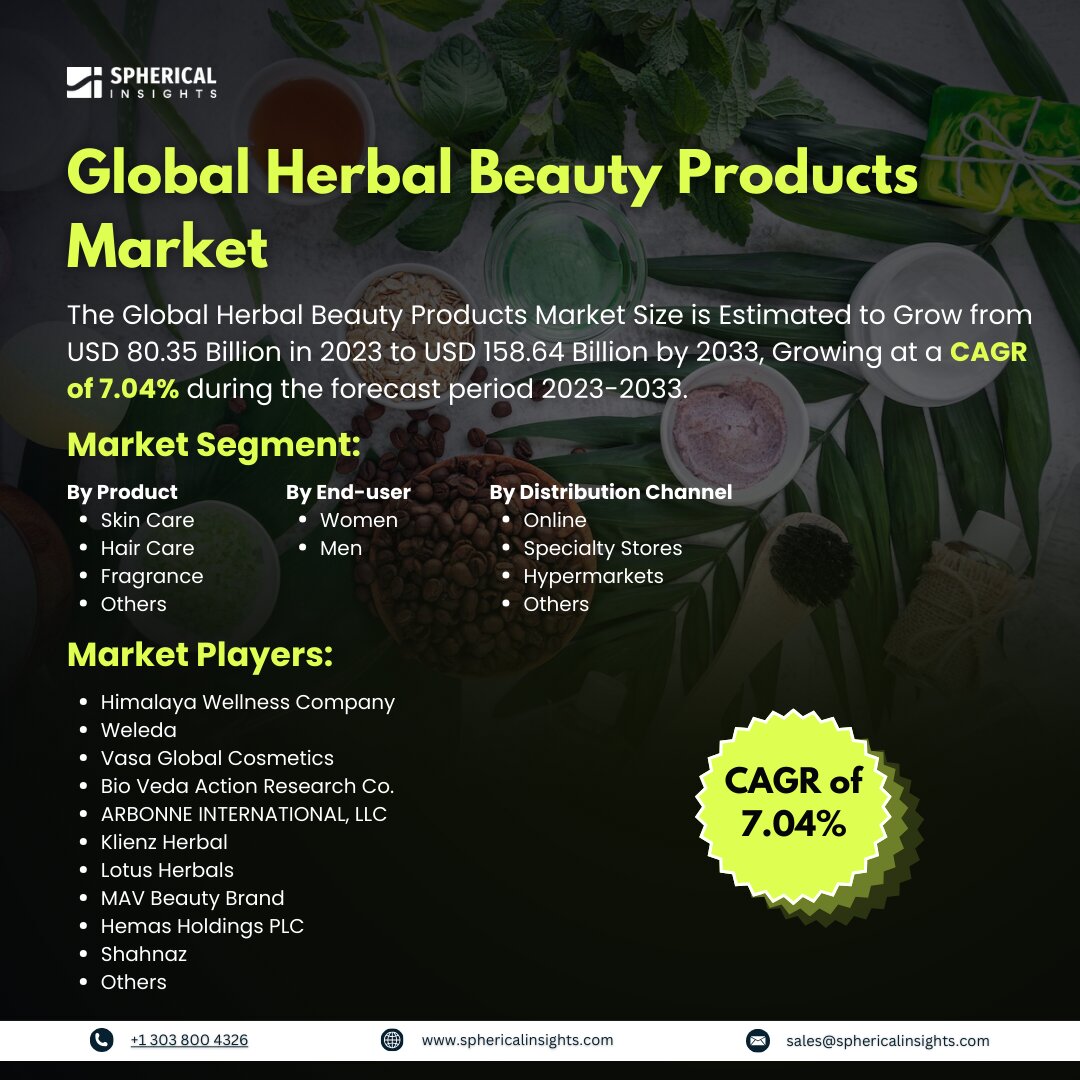Global Herbal Beauty Products Market Size to Worth USD 158.64 Billion by 2033
According to a research report published by Spherical Insights & Consulting, the Global Herbal Beauty Products Market Size is Estimated to Grow from USD 80.35 Billion in 2023 to USD 158.64 Billion by 2033, Growing at a CAGR of 7.04% during the forecast period 2023-2033.
Browse key industry insights spread across 215 pages with 110 Market data tables and figures & charts from the report on the Global Herbal Beauty Products Market Size, Share, and COVID-19 Impact Analysis, By Product (Skin Care, Hair Care, Fragrance, and Others), By End-user (Women and Men), By Distribution Channel (Online, Specialty Stores, Hypermarkets, and Others), and By Region (North America, Europe, Asia-Pacific, Latin America, Middle East, and Africa), Analysis and Forecast 2023 – 2033.
Products with natural ingredients sourced from various natural sources that affect skin functions and supply nutrients for healthy skin and hair are known as herbal beauty products. The market's expansion has been attributed to consumers' rising knowledge of the detrimental effects of synthetic chemicals present in conventional beauty products, which has caused them to turn to natural and organic alternatives. Herbal beauty products are declared to be safer and kinder to the skin because they are made from natural ingredients such as plants and herbs. Furthermore, the growing demand for clean beauty products that prioritize label clarity and steer clear of dangerous ingredients is driving market expansion. Social media and beauty experts, who frequently promote natural and herbal skincare routines, are also influencing consumer interest and sales. Furthermore, consumers' growing health consciousness and disposable budgets are promoting the use of high-end, environmentally friendly cosmetics. Well-established market companies have been concentrating on purchasing businesses in the natural beauty and personal care sectors to expand their customer base by attracting consumers who are becoming more and more interested in natural, herbal, and healthful products. However, the market's expansion is anticipated to be hampered by the changing preferences of consumers.
The skin care segment accounted for the largest market share of 34.56% in 2023 and is expected to grow at a significant CAGR during the forecast period.
Based on the product, the herbal beauty products market is categorized into skin care, hair care, fragrance, and others. Among these, the skin care segment accounted for the largest market share of 34.56% in 2023 and is expected to grow at a significant CAGR during the forecast period. The demand for skincare products is rising rapidly as more people become aware of the advantages of using natural and organic elements. With their natural extracts and low chemical content, herbal skincare products satisfy the needs of consumers who are looking for safe, helpful, and effective therapies for their skin issues. Since herbal skincare products are thought to be less irritating and more advantageous for long-term skin health, the growing prevalence of skin conditions including acne, aging, and sensitivity is also fueling demand for them.
The women segment is anticipated to hold a significant market share of the global herbal beauty products market through the projected period.
Based on the end-user, the herbal beauty products market is classified into women and men. Among these, the women segment is anticipated to hold a significant market share of the global herbal beauty products market through the projected period. Growing awareness of the possible negative effects of synthetic substances in traditional cosmetic products has led to a growing preference among women for natural and organic products. The growing clean beauty movement, which prioritizes natural formulas, sustainability, and transparency, is particularly appreciated by female consumers. Consumer interest and adoption of herbal beauty products are greatly increased by social media and beauty influencers.
The hypermarkets segment accounted for the largest market share of 32.84% in 2023 and is expected to grow at a significant CAGR during the forecast period.
Based on the distribution channel, the herbal beauty products market is divided into online, specialty stores, hypermarkets, and others. Among these, the hypermarkets segment accounted for the largest market share of 32.84% in 2023 and is expected to grow at a significant CAGR during the forecast period. Hypermarkets are an excellent option for customers looking for herbal beauty products because they have a variety of products under one roof. Physical product inspection improves the shopping experience and fosters customer trust, especially when combined with the availability of professional guidance and product demonstrations.
North America is expected to hold the largest share of the herbal beauty products market through the forecast period.
North America is expected to hold the largest share of the herbal beauty products market through the forecast period. Demand is rising rapidly as more individuals become aware of the advantages of using natural and organic substances in cosmetics. Clean beauty products with an emphasis on sustainability and transparency are highly valued by North American customers, especially those in the United States and Canada. Consumer interest and uptake of herbal beauty products are being driven by the influence of social media and beauty influencers. In addition, the region's robust offline and online retail infrastructure guarantees the widespread availability of a range of herbal beauty products. The region's market leadership is further supported by the steady opening of novel herbal formulations and the robust presence of well-known cosmetic brands.
Asia Pacific is predicted to grow at the fastest CAGR of the herbal beauty products market over the forecast period. The region's long history of employing herbal and traditional medicines for well-being and beauty is a major motivator. Leading the way in integrating cutting-edge herbal formulations into skincare products are nations with a reputation for having creative beauty industries, such as China, Japan, and South Korea. Premium herbal beauty products are becoming more and more popular as customers become more aware of the advantages of natural ingredients, their disposable incomes increase, and their living standards improve. Additional factors driving the market's growth are the influence of K-beauty and J-beauty trends, which frequently highlight natural and mild ingredients.
Competitive Analysis
Major key players in the herbal beauty products market include Himalaya Wellness Company, Weleda, Vasa Global Cosmetics, Bio Veda Action Research Co., ARBONNE INTERNATIONAL, LLC, Klienz Herbal, Lotus Herbals, MAV Beauty Brand, Hemas Holdings PLC., Shahnaz, and others.
Recent Developments
- In September 2024, using more than 24 whole herbs and traditional components including amla, bhringraj, shikakai, and Brahmi, Indus Valley Organic introduced its first ready-to-apply herbal hair care pastes.
- In June 2024, My Green Space launched the B2C market with a new line of herbal cosmetics that prioritized health and sustainability. Women's skin, hair, and face care needs are met by 100% natural products, which are cruelty-free, paraben-free, sulfate-free, and chemical-free.
Key Target Audience
- Market Players
- Investors
- End-users
- Government Authorities
- Consulting And Research Firm
- Venture capitalists
- Value-Added Resellers (VARs)
Market Segment
This study forecasts revenue at global, regional, and country levels from 2023 to 2033. Spherical Insights has segmented the herbal beauty products market based on the below-mentioned segments:
Global Herbal Beauty Products Market, By Product
- Skin Care
- Hair Care
- Fragrance
- Others
Global Herbal Beauty Products Market, By End-user
Global Herbal Beauty Products Market, By Distribution Channel
- Online
- Specialty Stores
- Hypermarkets
- Others
Global Herbal Beauty Products Market, By Regional Analysis
- North America
- Europe
- Germany
- UK
- France
- Italy
- Spain
- Russia
- Rest of Europe
- Asia Pacific
- China
- Japan
- India
- South Korea
- Australia
- Rest of Asia Pacific
- South America
- Brazil
- Argentina
- Rest of South America
- Middle East & Africa
- UAE
- Saudi Arabia
- Qatar
- South Africa
- Rest of the Middle East & Africa



